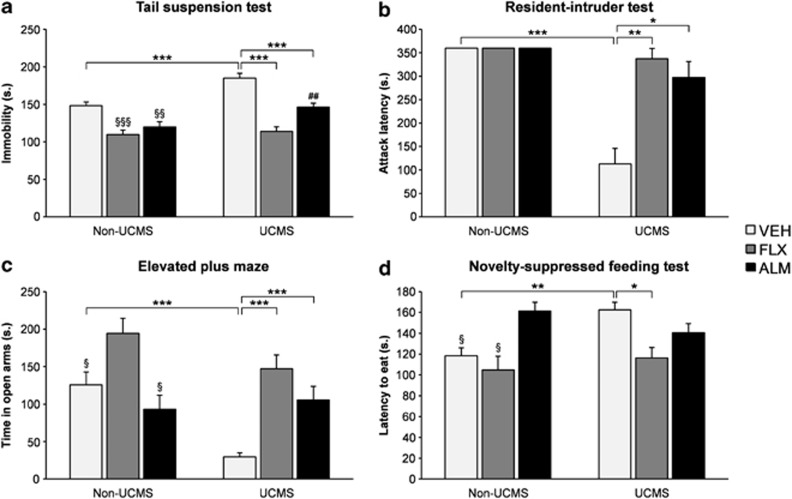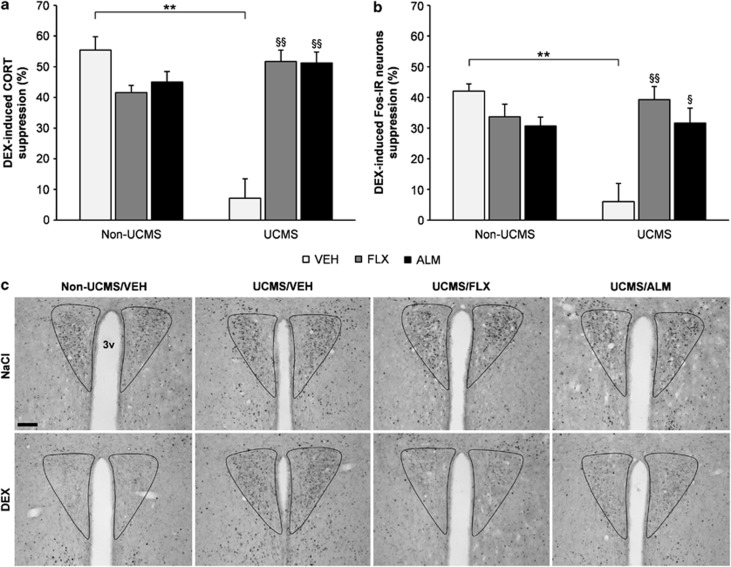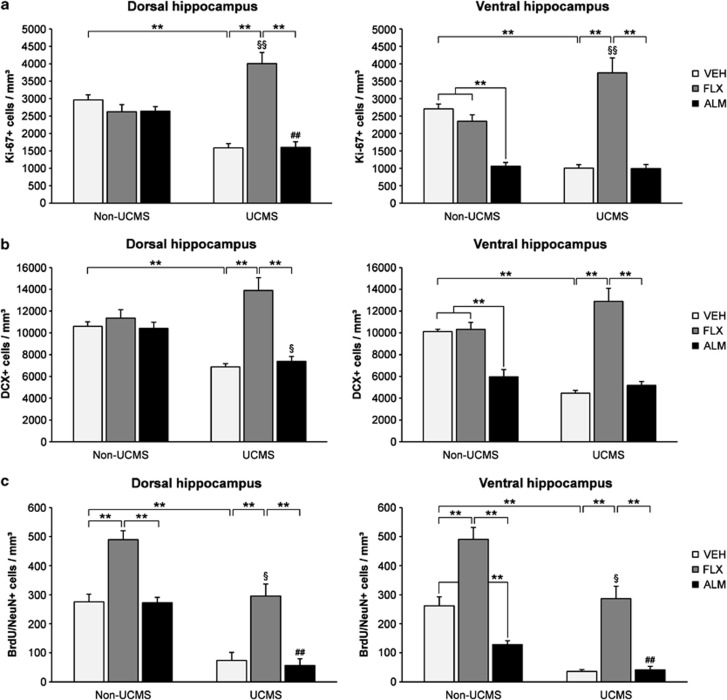
| Size | Price | Stock | Qty |
|---|---|---|---|
| 2mg |
|
||
| 5mg |
|
||
| 10mg |
|
||
| 25mg |
|
||
| 50mg |
|
||
| 100mg |
|
||
| 250mg |
|
||
| Other Sizes |
Purity: ≥98%
Almorexant HCl (also known as ACT-078573; ACT078573), the hydrochloride salt of Almorexant, is a novel, potent, orally bioactive, competitive and dual orexin1/2 receptor antagonist indicated for the treatment of sleep disorders/insomnia. It inhibits OX1 and OX2 receptors with IC50s of 6.6 nM and 3.4 nM, respectively. Almorexant exhibits competitive antagonistic effects on hOX1R and noncompetitive-like effects on hOX2R in the inositol phosphates assay. Almorexant also has an impact on sleep in a variety of species, including humans. In normal C57BL/6 mice, it dose-dependently shortens the amount of time spent awake and lengthens the amount of time spent in NREM and REM sleep.
| Targets |
human OX2R ( Kd = 0.17 nM ); human OX1R ( Kd = 1.3 nM ); Caspase-3
|
||
|---|---|---|---|
| ln Vitro |
|
||
| ln Vivo |
|
||
| Enzyme Assay |
Recent preclinical and clinical research has shown that Almorexant promotes sleep in animals and humans without disrupting the sleep architecture. Here, the pharmacology and kinetics of [(3)H]Almorexant binding to human orexin 1 receptor (OX(1))- and human orexin 2 receptor (OX(2))-human embryonic kidney 293 membranes were characterized and compared with those of selective OX(1) and OX(2) antagonists, including 1-(5-(2-fluoro-phenyl)-2-methyl-thiazol-4-yl)-1-((S)-2-(5-phenyl-(1,3,4)oxadiazol-2-ylmethyl)-pyrrolidin-1-yl)-methanone (SB-674042), 1-(6,8-difluoro-2-methyl-quinolin-4-yl)-3-(4-dimethylamino-phenyl)-urea (SB-408124), and N-ethyl-2-[(6-methoxy-pyridin-3-yl)-(toluene-2-sulfonyl)-amino]-N-pyridin-3-ylmethyl-acetamide (EMPA). The effect of these antagonists was also examined in vitro on the spontaneous activity of rat ventral tegmental area (VTA) dopaminergic neurons. [(3)H]Almorexant bound to a single saturable site on hOX(1) and hOX(2) with high affinity (K(d) of 1.3 and 0.17 nM, respectively). In Schild analyses using the [(3)H]inositol phosphates assay, Almorexant acted as a competitive antagonist at hOX(1) and as a noncompetitive-like antagonist at hOX(2). In binding kinetic analyses, [(3)H]almorexant had fast association and dissociation rates at hOX(1), whereas it had a fast association rate and a remarkably slow dissociation rate at hOX(2). In the VTA, orexin-A potentiated the basal firing frequency to 175 +/- 17% of control in approximately half of the neurons tested. In the presence of 1 microM SB-674042 or SB-408124, the effect of orexin-A was only partially antagonized. However, in the presence of 1 microM EMPA or 1 microM Almorexant, the effect of orexin-A was completely antagonized. In conclusion, Almorexant exhibited a noncompetitive and long-lasting pseudo-irreversible mode of antagonism as a result of its very slow rate of dissociation from OX(2). The electrophysiology data suggest that OX(2) might be more important than OX(1) in mediating the effect of orexin-A on slow-firing of VTA dopaminergic neurons.[2]
According to binding kinetic analyses, at hOX(1), [(3)H]almorexant exhibited fast association and dissociation rates, while at hOX(2), it exhibited a fast association rate and a remarkably slow dissociation rate. |
||
| Cell Assay |
Quantification of apoptotic cells by annexin V labelling[1]
AsPC-1, SW 1990, HPAF-II and HPAF-II/hOX1R cells (seeded at 5 × 104 cells/well) were grown as described above. The culture medium was then replaced every 24 hr with fresh medium with or without 1 μM orexin-A or Almorexant in the presence or in the absence of the SHP-2 inhibitor, NSC-87877 (50 μM). After 48 hr, apoptotic cells were determined using the Guava NexinTM kit. Results are expressed as the percentage of apoptotic phycoerythrin-labelled Annexin V (Annexin V-PE) positive cells and are the means of 3 independent analyses. Caspase-3 activity detection[1] AsPC-1 cells were pretreated 24 h without or with 50 μM SHP1/2 inhibitor NSC-87877. 5.106 semiconfluent cells were then treated with 1 μM orexin-A or 1 μM Almorexant in fresh culture medium at 37° C for 24 h. Caspase-3 activity detection was performed according to the manufacturer's instructions using the caspase-3 assay colorimetric kit. The caspase-3 activity measurement is based on spectrophotometric detection at 405 nm of the chromophore p-nitroaniline after cleavage by the activated caspase-3 from the labeled substrate DEVD-p-nitroaniline. Results are expressed as the optic density (O.D.) at 405 nm for 200 μg of protein for each sample and are the means of 3 independent analyses. Almorexant (also known as ACT078573) is a novel, potent, orally bioactive, competitive, oral bioactive, dual orexin receptor antagonist, with IC50 values for the OX1 and OX2 receptors of 6.6 nM and 3.4 nM, respectively. It might be used to treat sleeplessness. Almorexant functions as a competitive antagonist of hOX1R and a noncompetitive-like antagonist of hOX2R in the inositol phosphates assay. Moreover, Almorexant affects sleep in a variety of species, including humans. |
||
| Animal Protocol |
|
||
| ADME/Pharmacokinetics |
The mean plasma concentration-time profiles and the corresponding pharmacokinetic variables of almorexant are shown in Figure 1 and Table 1, respectively. Under fasting conditions, almorexant was rapidly absorbed, with a median tmax of 1.5 hours at all doses. After maximum plasma concentration (Cmax) was attained, plasma almorexant concentrations decreased quickly by 80% to 90% over the 8 hours after the tmax. Whereas the terminal elimination half-life (t1/2) was 32 hours, the t1/2α associated with the distribution phase, which is responsible for the major part of the drug disposition from plasma, varied from 1.4 to 1.7 hours between the dose groups. In line with low concentrations 8 hours after the tmax, simulation of multiple dosing conditions indicated minimal accumulation. The pharmacokinetics of almorexant were dose proportional, with a value (95% confidence limits [CI]) for the dose proportionality coefficient, β, of 1.11 (0.68–1.55) for the Cmax and 1.16 (0.87–1.46) for area under the concentration-time curve (AUC)0-∞. Plasma concentrations of zolpidem reached a maximum within 2 hours in all subjects, and the median tmax was 0.92 hours. Subsequently, zolpidem concentrations quickly decreased, and the mean terminal t1/2 was 3.1 hours (Table 1).
Compared with healthy adult male subjects, the essential pharmacokinetic characteristics of almorexant as a possible sleep-enabling agent, that is, rapid absorption and low drug concentrations 8 hours after dosing, were preserved in healthy elderly subjects. Nevertheless, some differences can be noted: at a dose of 200 mg, mean values (elderly vs younger subjects) for Cmax (166 vs 134 ng/mL), AUC0-∞ (722 vs 430 ng·h/mL), and t1/2 (31.8 vs 14.4 h) were higher in the elderly subjects compared with the adult subjects. The t1/2α associated with the distribution phase, which is responsible for the major part of drug disposition from plasma, was approximately 1.6 hours. The observed longer t1/2 and consequently greater AUC0-∞ may be explained by the extended blood-sampling scheme (72 hours in this study vs 36 hours in the previous study in adult male subjects), which allowed for a better estimation of t1/2 in this study. In addition, an effect of age on the clearance of almorexant by CYP3A4 cannot be excluded. In both populations, the pharmacokinetics of almorexant were approximately dose proportional but variable with a coefficient of variation of approximately 50%. The pharmacokinetics of zolpidem in the elderly subjects showed a higher Cmax and AUC0-∞ and longer t1/2 compared with the adult subjects consistent with previous reports. Reference: https://pubmed.ncbi.nlm.nih.gov/23609389/ |
||
| Toxicity/Toxicokinetics |
No serious AEs were reported, and all AEs resolved without sequelae. As expected with a sleep-enabling compound, somnolence and fatigue were reported frequently. Other frequent AEs included headache and nausea. Four subjects with muscle weakness, 3 subjects on almorexant 400 mg and one subject on placebo were reported; among them, 3 were mentioned retrospectively during self-assessment using the narcoleptic effects questionnaire. The total number of different AEs reported was higher with the 400 mg than with the other almorexant doses. None of the AEs reported with placebo or almorexant were of severe intensity.
There were no clinically relevant effects of almorexant on vital signs, electrocardiogram, body weight, clinical laboratory variables, and physical examination.
Administration of single morning doses of almorexant to healthy elderly subjects was well tolerated, with no severe or serious AEs, and no observed effects on clinical laboratory variables, vital signs, body temperature, body weight, or quantitative ECG variables. It should be emphasized that frail elderly subjects did not take part in the study and that no subjects older than 81 years were enrolled. The tolerability profile of almorexant in this study in healthy elderly subjects is similar to the one reported for healthy male adults who had received a single morning dose of almorexant from 1 to 1000 mg. Any AEs related to possible muscle tone abnormalities, sleep paralysis, and hallucinations should be carefully monitored in future studies with orexin receptor antagonists as narcolepsy could be theoretically an adverse effect of orexin receptor antagonists given that orexin levels are decreased in patients with this disorder. Reference: https://pubmed.ncbi.nlm.nih.gov/23609389/ |
||
| References | |||
| Additional Infomation |
Almorexant is a member of isoquinolines.
Drug Indication Investigated for use/treatment in sleep disorders and insomnia. Pancreatic ductal adenocarcinoma (PDAC) is still the poorest prognostic tumor of the digestive system. We investigated the antitumoral role of orexin-A and almorexant in PDAC. We analyzed the orexin receptor type 1 (OX1R) expression by immunohistochemistry in human normal pancreas, PDAC and its precursor dysplastic intraepithelial lesions. We used PDAC-derived cell lines and fresh tissue slices to study the apoptotic role of hypocretin-1/orexin-A and almorexant in vitro and ex vivo. We analyzed in vivo the hypocretin-1/orexin-A and almorexant effect on tumor growth in mice xenografted with PDAC cell lines expressing, or not, OX1R. Ninety-six percent of PDAC expressed OX1R, while adjacent normal exocrine pancreas did not. OX1R was expressed in pre-cancerous lesions. In vitro, under hypocretin-1/orexin-A and almorexant, the OX1R-positive AsPC-1 cells underwent apoptosis, abolished by the tyrosine phosphatase SHP2 inhibitor, NSC-87877, whereas the OX1R-negative HPAF-II cell line did not. These effects were mediated by phosphorylation of OX1R and recruitment of SHP2. Ex vivo, caspase-3 positive tumor cells were significantly higher in fresh tumour slices treated 48h with hypocretin-1/orexin-A, as compared to control, whereas cellular proliferation, assessed by Ki-67 index, was not modified. In vivo, when AsPC-1 cells or patient-derived cells were xenografted in nude mice, hypocretin-1/orexin-A or almorexant, administrated both starting the day of cell line inoculation or after tumoral development, strongly slowed tumor growth. Hypocretin-1/orexin-A and almorexant induce, through OX1R, the inhibition of PDAC cellular growth by apoptosis. Hypocretins/orexins and almorexant might be powerful candidates for the treatment of PDAC.[1] Study objectives: Humans with narcolepsy and orexin/ataxin-3 transgenic (TG) mice exhibit extensive, but incomplete, degeneration of hypo-cretin (Hcrt) neurons. Partial Hcrt cell loss also occurs in Parkinson disease and other neurologic conditions. Whether Hcrt antagonists such as almorexant (ALM) can exert an effect on the Hcrt that remains after Hcrt neurodegeneration has not yet been determined. The current study was designed to evaluate the hypnotic and cataplexy-inducing efficacy of a Hcrt antagonist in an animal model with low Hcrt tone and compare the ALM efficacy profile in the disease model to that produced in wild-type (WT) control animals. Design: Counterbalanced crossover study. Setting: Home cage. Patients or participants: Nine TG mice and 10 WT mice. Interventions: ALM (30, 100, 300 mg/kg), vehicle and positive control injections, dark/active phase onset. [3] Rationale: Orexins play a key role in the maintenance of alertness and are implicated in the modulation of diverse physiological processes, including cognitive function. Almorexant, a dual orexin receptor antagonist, transiently and reversibly blocks the action of orexin peptides at both OX(1) and OX(2) receptors and increases time spent in rapid eye movement (REM) and non-REM sleep. Objectives: We explored the direct effects on learning and memory of single and repeated administration of almorexant in rats. Methods: Following administration of high doses of almorexant (300 mg/kg, p.o.), scopolamine (0.8 mg/kg, i.p.), combination almorexant-scopolamine, or vehicle alone, rats were trained on a Morris water maze spatial navigation task, or on a passive avoidance task. Results: Rats treated with almorexant learned the spatial navigation task with similar efficacy as vehicle-treated animals. After 4 days, almorexant-but not vehicle-treated rats had established spatial memory; after 8 days, spatial memory had been established in both vehicle-and almorexant-treated rats. Scopolamine-treated rats failed to learn the spatial task. Both vehicle-and almorexant-but not scopolamine-treated rats demonstrated passive avoidance learning. Almorexant did not ameliorate scopolamine-induced impairment of learning in either task. Conclusions: Rats treated with almorexant are fully capable of spatial and avoidance learning.[4] |
| Molecular Formula |
C29H32CLF3N2O3
|
|
|---|---|---|
| Molecular Weight |
549.02
|
|
| Exact Mass |
548.205
|
|
| Elemental Analysis |
C, 63.44; H, 5.88; Cl, 6.46; F, 10.38; N, 5.10; O, 8.74
|
|
| CAS # |
913358-93-7
|
|
| Related CAS # |
Almorexant; 871224-64-5
|
|
| PubChem CID |
25227440
|
|
| Appearance |
White to off-white solid powder
|
|
| LogP |
6.872
|
|
| Hydrogen Bond Donor Count |
2
|
|
| Hydrogen Bond Acceptor Count |
7
|
|
| Rotatable Bond Count |
8
|
|
| Heavy Atom Count |
38
|
|
| Complexity |
722
|
|
| Defined Atom Stereocenter Count |
2
|
|
| SMILES |
C([C@@H]1N([C@H](C2C=CC=CC=2)C(=O)NC)CCC2=CC(=C(C=C12)OC)OC)CC1C=CC(C(F)(F)F)=CC=1.Cl
|
|
| InChi Key |
BYGBTDRDPBJUBB-LHIMUUITSA-N
|
|
| InChi Code |
InChI=1S/C29H31F3N2O3.ClH/c1-33-28(35)27(20-7-5-4-6-8-20)34-16-15-21-17-25(36-2)26(37-3)18-23(21)24(34)14-11-19-9-12-22(13-10-19)29(30,31)32;/h4-10,12-13,17-18,24,27H,11,14-16H2,1-3H3,(H,33,35);1H/t24-,27+;/m0./s1
|
|
| Chemical Name |
(2R)-2-[(1S)-6,7-dimethoxy-1-[2-[4-(trifluoromethyl)phenyl]ethyl]-3,4-dihydro-1H-isoquinolin-2-yl]-N-methyl-2-phenylacetamide;hydrochloride
|
|
| Synonyms |
|
|
| HS Tariff Code |
2934.99.9001
|
|
| Storage |
Powder -20°C 3 years 4°C 2 years In solvent -80°C 6 months -20°C 1 month Note: Please store this product in a sealed and protected environment, avoid exposure to moisture. |
|
| Shipping Condition |
Room temperature (This product is stable at ambient temperature for a few days during ordinary shipping and time spent in Customs)
|
| Solubility (In Vitro) |
|
|||
|---|---|---|---|---|
| Solubility (In Vivo) |
Solubility in Formulation 1: ≥ 2.5 mg/mL (4.55 mM) (saturation unknown) in 10% DMSO + 40% PEG300 + 5% Tween80 + 45% Saline (add these co-solvents sequentially from left to right, and one by one), clear solution.
For example, if 1 mL of working solution is to be prepared, you can add 100 μL of 25.0 mg/mL clear DMSO stock solution to 400 μL PEG300 and mix evenly; then add 50 μL Tween-80 to the above solution and mix evenly; then add 450 μL normal saline to adjust the volume to 1 mL. Preparation of saline: Dissolve 0.9 g of sodium chloride in 100 mL ddH₂ O to obtain a clear solution. Solubility in Formulation 2: ≥ 2.5 mg/mL (4.55 mM) (saturation unknown) in 10% DMSO + 90% (20% SBE-β-CD in Saline) (add these co-solvents sequentially from left to right, and one by one), clear solution. For example, if 1 mL of working solution is to be prepared, you can add 100 μL of 25.0 mg/mL clear DMSO stock solution to 900 μL of 20% SBE-β-CD physiological saline solution and mix evenly. Preparation of 20% SBE-β-CD in Saline (4°C,1 week): Dissolve 2 g SBE-β-CD in 10 mL saline to obtain a clear solution. View More
Solubility in Formulation 3: ≥ 2.5 mg/mL (4.55 mM) (saturation unknown) in 10% DMSO + 90% Corn Oil (add these co-solvents sequentially from left to right, and one by one), clear solution. Solubility in Formulation 4: 2% DMSO+25% β-cyclodextrin+saline: 9 mg/mL |
| Preparing Stock Solutions | 1 mg | 5 mg | 10 mg | |
| 1 mM | 1.8214 mL | 9.1071 mL | 18.2143 mL | |
| 5 mM | 0.3643 mL | 1.8214 mL | 3.6429 mL | |
| 10 mM | 0.1821 mL | 0.9107 mL | 1.8214 mL |
*Note: Please select an appropriate solvent for the preparation of stock solution based on your experiment needs. For most products, DMSO can be used for preparing stock solutions (e.g. 5 mM, 10 mM, or 20 mM concentration); some products with high aqueous solubility may be dissolved in water directly. Solubility information is available at the above Solubility Data section. Once the stock solution is prepared, aliquot it to routine usage volumes and store at -20°C or -80°C. Avoid repeated freeze and thaw cycles.
Calculation results
Working concentration: mg/mL;
Method for preparing DMSO stock solution: mg drug pre-dissolved in μL DMSO (stock solution concentration mg/mL). Please contact us first if the concentration exceeds the DMSO solubility of the batch of drug.
Method for preparing in vivo formulation::Take μL DMSO stock solution, next add μL PEG300, mix and clarify, next addμL Tween 80, mix and clarify, next add μL ddH2O,mix and clarify.
(1) Please be sure that the solution is clear before the addition of next solvent. Dissolution methods like vortex, ultrasound or warming and heat may be used to aid dissolving.
(2) Be sure to add the solvent(s) in order.
| NCT Number | Recruitment | interventions | Conditions | Sponsor/Collaborators | Start Date | Phases |
| NCT00608985 | Completed | Drug: almorexant Drug: Placebo |
Primary Insomnia | Midnight Pharma, LLC | March 2008 | Phase 3 |
| NCT01243060 | Completed | Drug: Almorexant Drug: Zolpidem 10mg |
Healthy Volunteers | Northern California Institute of Research and Education | May 2011 | Not Applicable |
| NCT00640848 | Completed | Drug: almorexant | Schizoaffective Disorder Schizophrenia |
Insomnia Primary Insomnia |
May 2006 | Phase 1 |
| NCT01987739 | Completed | Drug: 200 mg almorexant Drug: 400 mg almorexant |
Abuse Potential Study | Midnight Pharma, LLC | September 2009 | Phase 1 |
  |
 |